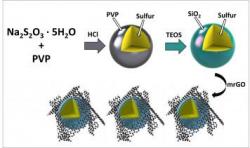Researchers from the Bourns College of Engineering at the University of California, Riverside investigated a strategy to improve lithium-sulfur batteries' performance by creating nano-sized sulfur particles, and coating them in glass.

Lithium-sulfur batteries have been attracting attention thanks to their ability to produce up to 10 times more energy than conventional batteries, but one of the main roadblocks to implementing them is a the tendency for lithium and sulfur reaction products (called lithium polysulfides) to dissolve in the battery’s electrolyte and travel to the opposite electrode permanently, which causes the battery’s capacity to decrease over its lifetime. The scientists designed a cathode material in which silica (glass) cages trap polysulfides.. The team used an organic precursor to construct the trapping barrier.
The team found that silica-caged sulfur particles provided a substantially higher battery performance, but felt further improvement was necessary because of the challenge with the breakage of the SiO2 shell. They then descided to incorporate mildly reduced graphene oxide (mrGO) as a conductive additive in cathode material design, to provide mechanical stability to the glass caged structures. This new cathode provided an even more dramatic improvement than the first design, since the team engineered both a polysulfide-trapping barrier and a flexible graphene oxide blanket that harnesses the sulfur and silica together during cycling.